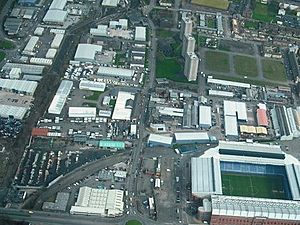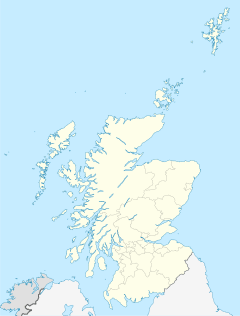Moorepark, Glasgow facts for kids
Quick facts for kids Moorepark |
|
|---|---|
 Aerial view from the south featuring Moorepark (left half of image) in its current industrial form - also showing proximity to Ibrox Stadium |
|
| OS grid reference | NS552649 |
| Council area | |
| Lieutenancy area |
|
| Country | Scotland |
| Sovereign state | United Kingdom |
| Post town | GLASGOW |
| Postcode district | G51 2 |
| Dialling code | 0141 |
| Ambulance | Scottish |
| EU Parliament | Scotland |
| UK Parliament | |
| Scottish Parliament | |
Moorepark is a small area located in Glasgow, a big city in Scotland. It's found south of the River Clyde. For a while, in the middle to late 1900s, it was known as 'Wine Alley' because of a housing area there. Today, Moorepark is an industrial estate, which means it's a place with many businesses and factories.
Contents
A Look Back: Moorepark's History
Moorepark started as a large country estate. In the early 1800s, a big house called Moore Park was built there for the Hagart family. A famous architect named David Hamilton designed it.
Around the 1870s, a railway company bought the estate. The mansion house was then taken down. By the early 1900s, Moorepark was surrounded by shops, apartments, and railway lines.
Building New Homes
Because it was a good spot for building, Glasgow Corporation bought the land in 1934. They built the Moorepark Housing Estate. This was a typical Glasgow rehousing scheme, with three-story buildings made of grey concrete blocks.
Most of the new people moving in came from the Gorbals area, not from nearby Govan. Govan had its own problems with too many people living in small, old apartments. Some local people were not happy about the newcomers.
The "Wine Alley" Nickname
The area became known as "Wine Alley." This nickname stuck because of some challenges in the housing estate. Moorepark was also surrounded by factories and a railway line. Like other housing projects at the time, it faced issues. These included building materials that weren't the best and not many local shops or services.
The area also had problems because local industries, like shipbuilding in Govan, were closing down. This nickname gave Moorepark a challenging reputation in the city.
Moorepark on TV
The BBC Scotland television comedy series Rab C. Nesbitt sometimes made fun of the area. The show was set in Wine Alley and the wider Govan area. However, episodes were rarely filmed there.
From Homes to Businesses
In the 1990s, the Moorepark housing area was taken down. It was then changed into an industrial estate. A nearby housing area called Teucharhill, which also had a challenging reputation, was changed at the same time.
Sports in Moorepark
The area was connected to the Junior football team St Anthony's. They had two football grounds in Moorepark.
The first ground, called Moorepark Grounds, was north of the old mansion. It was used from the early 1900s. This ground was removed to make way for the new housing development.
The second ground, called New Moore Park, opened in 1929. It was southwest of the neighborhood, off Edmiston Drive. This ground also fell into disrepair. In the early 2000s, a business park was built there instead. The St Anthony's football club moved to new facilities in Shieldhall after a few years of not having a permanent home.
Getting Around Moorepark
The Moorepark area has its own subway station. It's called Ibrox subway station. You can find it on the Glasgow Subway system, at the corner of Copland Road and Woodville Street.
See also


